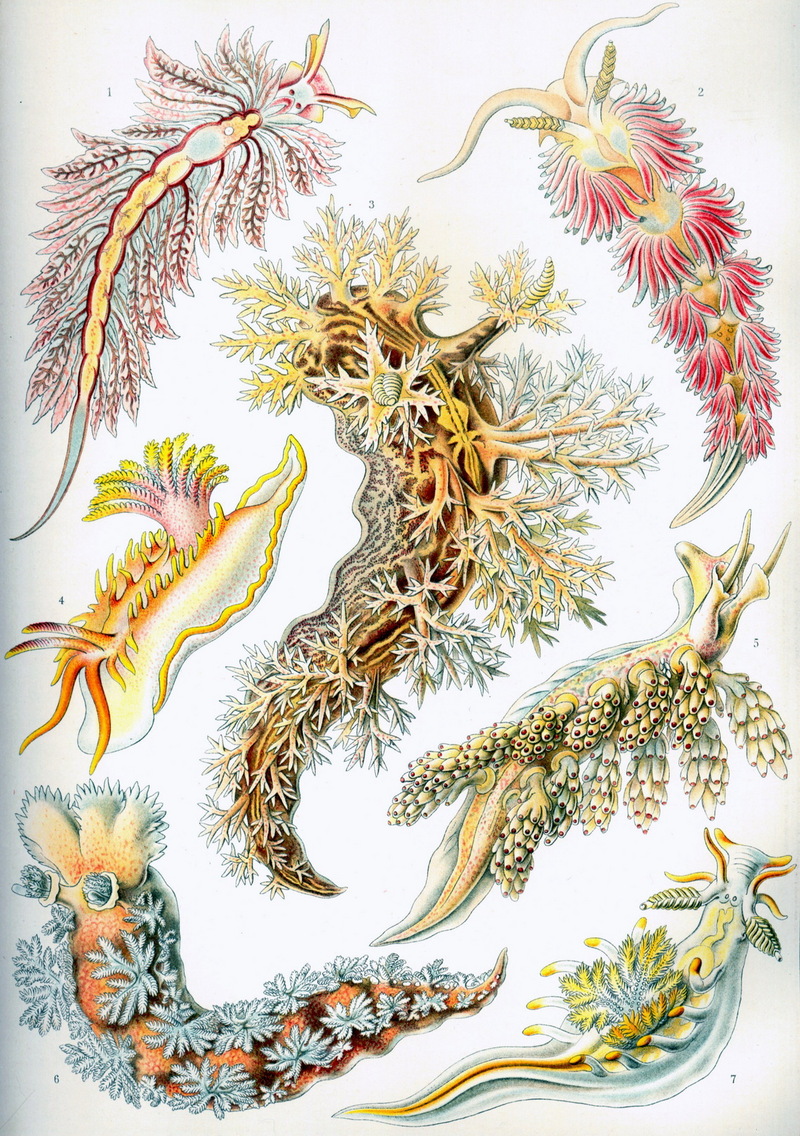Nudibranch (Order: Opisthobranchia, Suborder: Nudibranchia) - Wiki Nudibranch
From Wikipedia, the free encyclopedia
[Photo] "Nudibranchia", from Ernst Haeckel's Artforms of Nature, 1904. The 43rd plate from Ernst Haeckel's Kunstformen der Natur (1904), depicting organisms classified as Nudibranchia. Species: Hermaea bifida, Aeolis coronata, Dendronotus arborescens, Idalia elegans, Doto coronata, Tritonia hombergii, Ancula cristata
Nudibranchs, also known as sea slugs, are soft-bodied marine snails belonging to the suborder Nudibranchia, the largest suborder of the order Opisthobranchia. There are more than 3,000 described species.
Description
The adult form is without a shell or operculum (a bony plate covering the opening of the shell, when the body is withdrawn).
The word "nudibranch" comes from Latin nudus meaning "naked", and Greek brankhia meaning "gills". The name is appropriate since the dorids (infraclass Anthobranchia) breathe through a branchial plume of bushy extremities on their back, rather than using gills. By contrast, on the back of the aeolids in infraclass Cladobranchia there are brightly colored sets of tentacles called cerata.
Nudibranchs have cephalic (head) tentacles, which are sensitive to touch, taste, and smell. Club-shaped rhinophores detect the odors.
They are hermaphroditic, but can rarely fertilize themselves.
Nudibranchs typically deposit their eggs within a gelatinous spiral.
They are carnivorous. Some feed on sponges, others on hydroids, others on bryozoans, and some are cannibals, eating other sea slugs, or, on some occasions, members of their own species. There is also a group that feeds on tunicates and barnacles.
Body forms can vary wildly. They lack a mantle cavity. Their size varies from 40 to 600 mm.
They occur worldwide at all depths, but they reach their greatest size and variation in warm, shallow waters.
Among them can be found the most colorful creatures on earth. Because sea slugs, in the course of evolution, have lost their shell, they have had to evolve another means of defense: camouflage, through color patterns that make them invisible (cryptic behavior) or warn off predators as being distasteful or poisonous (aposematic behavior). Champions in their colorful display are the Chromodorids. The nudibranchs that feed on hydroids store the hydroid's nematocysts (stinging cells) in the dorsal body wall. This enables the nudibranch to ward off potential predators.
Taxonomy
The taxonomy of the Nudibranchia is still evolving. Many taxonomists used to treat Nudibranchia as an order, based on the authoritative work of Johannes Thiele (1931), who built on the concept of Henri Milne-Edwards (1848). But new insights through morphological data and gene-sequence research, cause some confidence in the congruence of the data sets of the new and the old. On the basis of investigation of 18S rDNA sequence data, there has been found strong evidence for support of the monophyly of the Nudibranchia and its two major groups, the Anthobranchia/Doridoidea and Cladobranchia
Infraorder Anthobranchia F??russac, 1819 (dorids)
Superfamily Doridoidea Rafinesque, 1815
Superfamily Doridoxoidea Bergh, 1900
Superfamily Onchidoridoidea Alder & Hancock, 1845
Superfamily Polyceroidea Alder & Hancock, 1845
Infraorder Cladobranchia Willan & Morton, 1984 (aeolids)
Superfamily Aeolidioidea J. E. Gray, 1827
Superfamily Arminoidea Rafinesque, 1814
Superfamily Dendronotoidea Allman, 1845
Superfamily Metarminoidea Odhner in Franc, 1968
A new study, published in May 2001, has again revised the taxonomy of the Nudibranchia. They are thus divided into two major clades:
Anthobranchia (= Bathydoridoidea + Doridoidea)
Dexiarchia nom. nov. (= Doridoxoidea + Dendronotoidea + Aeolidoidea + “Arminoidea”).
The dorids (infraorder Anthobranchia) have the following characteristics: the branchial plume forms a cluster on the posterior part of the neck, around the eyes. Fringes on the mantle do not contain any intestines.
The aeolids (infraorder Cladobranchia) have the following characteristics: Instead of the branchial plume, they have cerata. They lack a mantle. Only species of the Cladobranchia are reported to home. zooxanthellae.
The Birch Aquarium at La Jolla, California, has the largest collection of nudibranchs on display in the U.S.A.
http://en.wikipedia.org/wiki/Nudibranch
| The text in this page is based on the copyrighted Wikipedia article shown in above URL. It is used under the GNU Free Documentation License. You may redistribute it, verbatim or modified, providing that you comply with the terms of the GFDL. |
